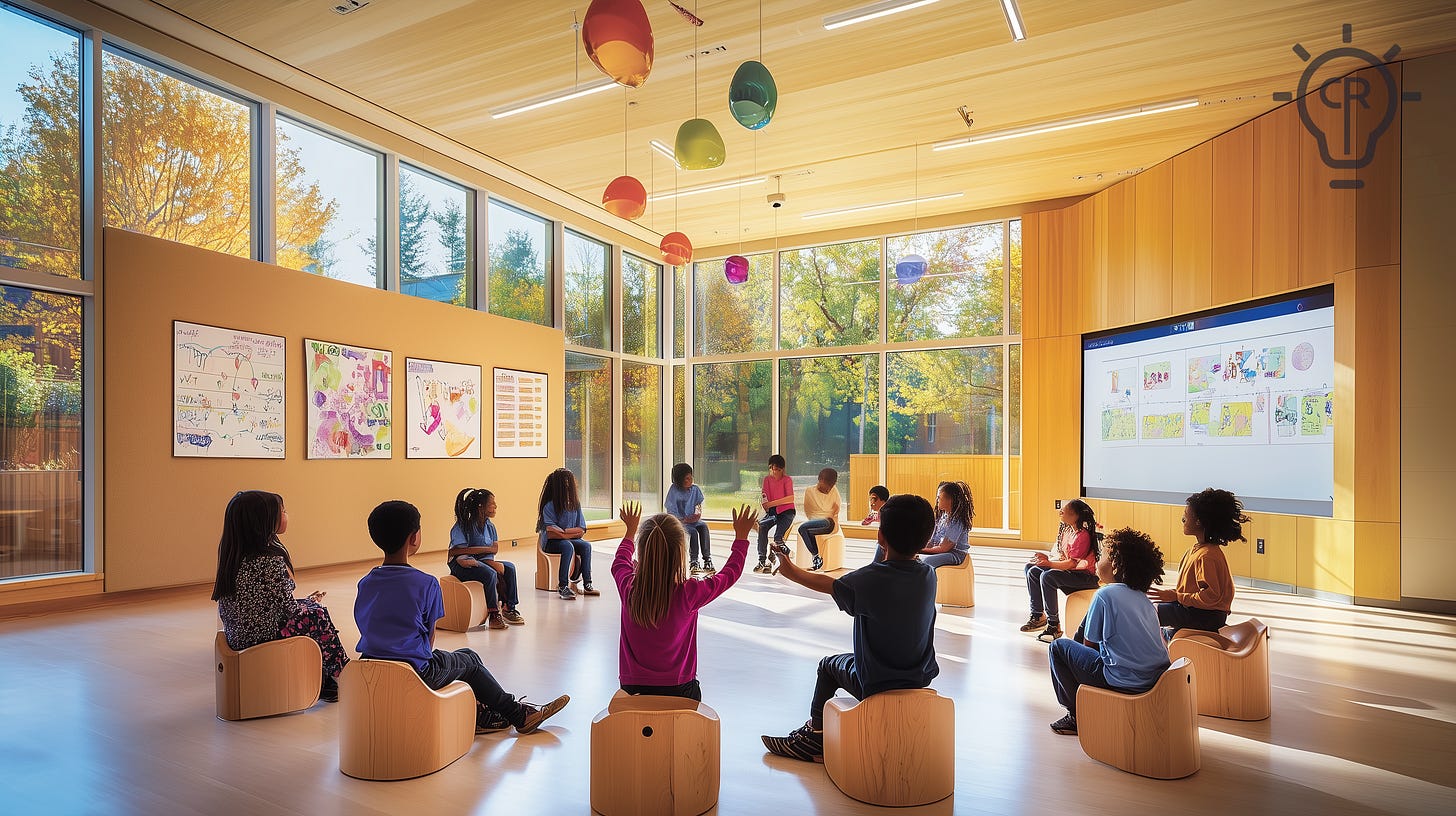💡 This Week’s Insight:
Optimizing classroom lighting isn’t just about comfort—it can improve reading scores by 26%, boost focus, and reduce disruptive behavior.
Most teachers can make measurable changes without spending more than $30.
One Classroom’s Biggest Problem Might Be Above Your Head
When touring schools around the world, I’ve seen it time and again: classrooms with harsh, high-intensity, and uniform lighting often experience more behavioral disruptions and lower academic performance
Let me illustrate this with a story.
While visiting a high school in Arizona, I stepped into a science classroom where the blinds were fully closed and the room was noticeably dark. The teacher stood at the front, presenting material on an LED screen, and the students sat quietly—almost too quietly.
I asked the teacher if he usually kept the blinds closed. He explained that it helped students stay focused on the screen and minimized distractions. But when I asked the students how they felt about the space, one young woman didn’t hesitate:
“It’s soul-crushing.”
That moment stuck with me. Natural light and views outside aren't just aesthetic preferences—they offer students a sense of autonomy, support emotional regulation, and contribute to a feeling of well-being. These are the conditions in which learning flourishes. In fact, a major study by the Heschong Mahone Group found that students in classrooms with the most daylight progressed 26% faster in reading and 20% faster in math than students in classrooms with the least daylight exposure.
When we over-control the environment, we risk shutting students down, not just emotionally, but cognitively too.
The Science Is Clear
Humans evolved under dynamic, natural light—not flickering fluorescents. Artificial lighting disrupts biological systems that regulate mood, alertness, and cognition.
💡 Why it matters:
Natural light improves the production of cortisol and melatonin
These hormones influence the brain’s prefrontal cortex (where attention, planning, and impulse control live)
Better lighting = stronger executive function = better learning
When we improve classroom lighting, we’re shaping the neurological conditions for learning.
Why Boys React Differently
Research shows that male and female visual systems respond differently to environmental stimuli like contrast and motion.
Males often show:
Greater sensitivity to flicker
Faster detection of fine visual detail and motion
Stronger contrast response due to more androgen receptors in the visual cortex
These differences mean that poorly optimized lighting—especially flickering fluorescents—may affect boys’ attention more acutely. If you’ve noticed certain students zoning out under overhead lights, this could be why.
ADHD & Flickering Light
Students with attention challenges or sensory sensitivity are especially vulnerable to poor lighting. Even flicker that's imperceptible to the eye can trigger cognitive disruption.
Brain scans show that near-threshold flicker activates frontal and parietal areas tied to attention and scanning. This creates a background “buzz” in the brain, pulling students away from the task at hand.
While specific improvement percentages vary, teachers consistently observe:
Less fidgeting and eye-scanning
More time on task
Better reading and test focus
If you’ve worked with neurodiverse students, you’ve likely seen this in action. Better lighting doesn’t just feel better—it removes barriers to focus.
💡 What Works: Strategic Lighting Adjustments
1. Diffuse, Don’t Eliminate, Natural Light
Use translucent roller shades or cellular blinds, not blackout blinds
Place plants near windows to break up glare naturally
Tilt blinds to allow indirect sunlight while blocking screen glare

2. Create Light Zones in the Room
Add table or floor lamps with full-spectrum bulbs
Let students choose seating based on comfort and activity
Use softer light areas for calming activities, and brighter areas for group work

3. Align Activities with Natural Light Cycles
Schedule cognitively demanding tasks for the morning
Dim lighting slightly in the afternoon to reduce fatigue
Embrace “light hygiene”: open windows early, adjust as the day progresses

Even simple changes can improve focus and engagement. Classrooms that used strategies like these saw up to 12% higher test scores compared to those with blacked-out windows.
Low-Cost Lighting Hacks for Any Teacher
Working with a small budget? Here’s what you can do this week:
Try This: One-Minute Lighting Audit
Ask yourself:
When and where does natural light enter your room?
Where do students seem most distracted?
Are any students squinting or fidgeting more than others?
Can I move just one lamp or one blind to make a difference?
Start small. That $20 filter you install this week might unlock 10 more minutes of daily focus for a struggling student.
What’s Worked for You?
Have you seen lighting impact your students’ mood or performance?
What quick fixes have made a difference in your classroom?
Hit “reply” or comment below—we’d love to feature your story in an upcoming issue.
After all, learning is illumination, in more ways than one.
— Randy
📚 Source Summary
Heschong Mahone Group (1999) Daylighting in Schools
GEN News (2012) Why Men and Women See Things Differently
Carmel, Lavie & Rees (2006) Conscious awareness of flicker in humans involves frontal and parietal cortex (Current Biology)





Hi Randy,
This is such a hopeful and well thought out perspective about the power of adaptations in lighting to support student learning. Lighting is too often neglected in proposals to humanize students’ experience and enhance their outcomes. Your conceptually grounded and practical suggestions are big steps toward overcoming this neglect. Your contribution, in concert with others in your series, will make an important difference in classroom life and learning.